Important Questions of Magnetic Effects of Electric Current Class 10 Science Chapter 13
Question 1.
What is meant by magnetic field?
Year of Question :(2012)
Answer:
Magnetic field : It is defined as the space surrounding the magnet in which magnetic force can be experienced
Question 2.
Draw magnetic field lines around a bar magnet. Name the device which is used to draw magnetic field lines?
Year of Question :(2015)
Answer:
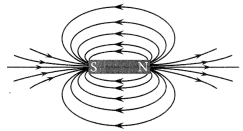 Compass needle is used to draw magnetic field lines
Compass needle is used to draw magnetic field lines
Question 3.
Design an activity to demonstrate that a bar magnet has a magnetic field around it?
Year of Question :(2017)
Answer:
One can easily demonstrate the presence of field lines around a bar magnet using compass needles. Place the magnet on a white sheet and mark its boundaries on sheet. Place the compass near the north pole of magnet and mark the position of needle. Now move the compass such that its south pole occupies the position previously occupied by its north pole. Repeat this step several times and you will have pattern as shown in the figure
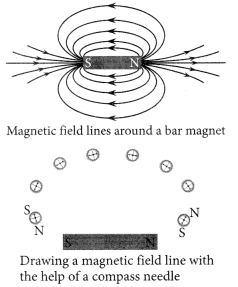 Repeat the above procedure and draw as many lines as you can. These lines represent the magnetic field around the magnet. These are known as magnetic field lines
Repeat the above procedure and draw as many lines as you can. These lines represent the magnetic field around the magnet. These are known as magnetic field lines
Question 4.
What are magnetic field lines? Justify the following statements?
Year of Question :(2012)
- (a) Two magnetic field lines never intersect each other
- (b) Magnetic field are closed curves
Answer:
Imaginary continuous closed curves used to represent the magnetic field in a region is known as magnetic field lines. It is directed from north pole to south pole outside the magnet and south pole to north pole inside the magnet.
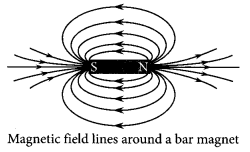
- (a) The direction of magnetic field (B) at any point is obtained by drawing a tangent to the magnetic field line at that point. In case, two magnetic field lines intersect each other at the point P as shown in figure, magnetic field at P will have two directions, shown by two arrows, one drawn to each magnetic field line at P, which is not possible.

- (b) It is taken by convention that the field lines emerges from north pole and merge at the south pole. Inside the magnet, the direction of field lines is from its south pole to its north pole. Thus, the magnetic field lines are closed curves
Question 5.
- (a) What is meant by a magnetic field? Mention two parameters that are necessary to describe it completely
- (b) If field lines of a magnetic field are crossed at a point, what does it indicate
Answer:
- Necessary parameters are
?- Magnitude of magnetic field
?- Direction of field lines
- (b) If field lines of a magnetic field are crossed at a point, it indicates that there are two direction of magnetic field at a point which is not possible
Question 6.
A compass needle is placed near a current carrying straight conductor. State your observation for the following cases and give reasons for the same in each case?
Year of Question :(2012)
- (a) Magnitude of electric current is increased
- (b) The compass needle is displaced away from the conductor
Answer:
- (a) As the amount of magnetic field strength is directly proportional to the amount of current, so the deflection of compass needle increases
- (b) Since magnetic field strength at a point is inversely proportional to the distance from the wire. Hence deflection of compass decreases when it is displaced away from the conductor
Question 7.
State how the magnetic field produced by a straight current carrying conductor at a point depends on?
Year of Question :(2012)
- (a) current through the conductor
- (b) distance of point from conductor
Answer:
Strength of magnetic field produced by a straight current-carrying wire at a given point is
- (a) directly proportional to the current passing through it
- (b) inversely proportional to the distance of that point from the wire.

Question 8.
Give reason for the following?
Year of Question :(2012)
- (i) There is either a convergence or a divergence of magnetic field lines near the ends of a current carrying straight solenoid
- (ii) The current carrying solenoid when suspended freely rests along a particular direction. (2/3, 2020)
Answer:
- (i) There is either a convergence or a divergence of magnetic field lines near the ends of a current carrying straight solenoid because it behaves similar to that of a bar magnet and has a magnetic field line pattern similar to that of a bar magnet. Thus the ends of the straight solenoid behaves like poles of the magnet, where the converging end is the south pole and the diverging end is the north pole
- (ii) The current carrying solenoid behaves similar to that of a bar magnet and when freely suspended aligns itself in the north-south direction
Question 9.
Find the direction of magnetic field due to a current carrying circular coil held?
Year of Question :(2012)
- (i) vertically in North - South plane and an observer looking it from east sees the current to flow in anticlockwise direction
- (ii) vertically in East - West plane and an observer looking it from south sees the current to flow in anticlockwise direction
- (iii) horizontally and an observer looking at it from below sees current to flow in clockwise direction .(Board Term I, 2017)
Answer:
According to right hand rule, the direction of magnetic field is
- (i) west to east
- (ii) north to south
- (iii) into the paper
Question 10.
- (a) State three factors on which the strength of magnetic field produced by a current carrying solenoid depends
- (b) Draw circuit diagram of a solenoid to prepare an electromagnet. (Board Term I, 2016)
Answer:
- (a) Strength of magnetic field produced by a current carrying solenoid depends upon the following factors
?- number of turns in the coil
?- amount of current flowing through it
?- radius of coil
?- Material of core of the solenoid
- (b) A strong magnetic field produced inside a solenoid can be used to magnetise a piece of magnetic material, like soft iron, when placed inside the coil. The magnet so formed is called an electromagnet.
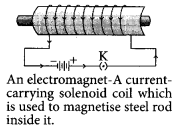
Question 11.
- (a) State Right Hand Thumb rule to find the direction of the magnetic field around a current carrying straight conductor
- (b) How will the magnetic field be affected on:
- (i) increasing the current through the conductor
- (ii) reversing the direction of flow of current in the conductor? (Board Term I, 2015)
Answer:
- (a) It states that you are holding a current carrying straight conductor in your right hand such that the thumb points towards the direction of current. Then your finger will wrap around the conductor in the direction of the field lines of the magnetic field
- (b) (i) If the current is increased, the magnetic field strength also increases.
- (ii) If the direction of current is reversed, the direction of magnetic field also get reversed
Question 12.
Diagram shows the lengthwise section of a current carrying solenoid. ? indicates current entering into the page, ? indicates current emerging out of the page. Decide which end of the solenoid A or B, will behave as north pole. Give reason for your answer. Also draw field lines inside the solenoid?
Year of Question :(2012)

Answer:
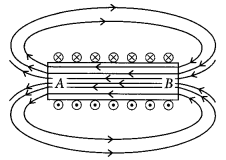 Using right hand thumb rube we can draw the magnetic field lines around the conductor as shown. From figure, end A of solenoid act as north pole and end B will act as south pole. Inside the solenoid field lines are in the form of parallel straight lines
Using right hand thumb rube we can draw the magnetic field lines around the conductor as shown. From figure, end A of solenoid act as north pole and end B will act as south pole. Inside the solenoid field lines are in the form of parallel straight lines
Question 13.
Write one application of right hand thumb rule?
Year of Question :(2013)
Answer:
It is used to find the direction of magnetic field around a current carrying conductor
Question 14.
- (a) What is an electromagnet? List any two uses
- (b) Draw a labelled diagram to show how an electromagnet is made
- (c) State the purpose of soft iron core used in making an electromagnet
- (d) List two ways of increasing the strength of an electromagnet if the material of the electromagnet is fixed. (2020)
Answer:
Electromagnets are used in electric motors and generators, electric bells and buzzers, loudspeakers and headphones etc
- (c) The soft iron core placed in an electromagnet increases the strength of the magnetic field produced. Thus increasing the strength of electromagnet
- (d) The strength of electromagnet can be increased by
- (i) Increasing the current passing through the coil
- (ii) Increasing the number of turns in the coil
Question 15.
What is solenoid? Draw the pattern of magnetic field lines of?
Year of Question :(2012)
- (i) a current carrying solenoid and
- (ii) a bar magnet
- List two distinguishing features between the two fields. (Delhi 2019)
Answer:
- (i) Solenoid : A coil of many circular turns of insulated copper wire wrapped in the shape of cylinder is called solenoid.
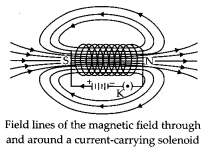 The pattern of magnetic field lines inside the solenoid indicates that the magnetic field is the same at all points inside the solenoid. That is, the field is uniform inside the solenoid
The pattern of magnetic field lines inside the solenoid indicates that the magnetic field is the same at all points inside the solenoid. That is, the field is uniform inside the solenoid
- (ii) Magnetic field lines around a bar magnet
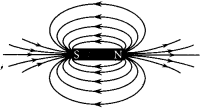 Following are the distinguishing features between the two fields
Following are the distinguishing features between the two fields
- (a) A bar magnet is a permanent magnet whereas solenoid is an electromagnet, therefore field produced by solenoid is temporary and stay till current flows through it
- (b) Magnetic field produced by solenoid is more stronger than magnetic field of a bar magnet
Question 16.
What are magnetic field lines? List three characteristics of these lines. Describe in brief an activity to study the magnetic field lines due to a current carrying circular oil?
Year of Question :(2016)
Answer:
Magnetic field lines : These are the imaginary close curves which are used to represent the magnetic field around the magnet.
The properties of the magnetic field lines are listed below
?- Magnetic field lines start at the north pole and end at the south pole
?- Magnetic field lines do not intersect each other, because there cant be two directions of the magnetic field at any one point
?- The degree of closeness of the field lines depends upon the strength of the magnetic field. Stronger the field, closer are the field lines
- In order to find the magnetic field due to a coil, it is held in a vertical plane and is made to pass through a smooth cardboard in such a way that the centre (O) of the coil lies at the cardboard. A current is passed through the coil and iron filings are sprinkled on the cardboard. These iron filings arrange themselves in a pattern similar to one shown in the figure. This pattern represents the magnetic field lines due to the coil
- In order to find the direction of magnetic field lines, we plot the magnetic field with the help of a compass needle. The pattern of magnetic field lines so obtained is shown in figure (b). From this pattern, the following important conclusion have been drawn.
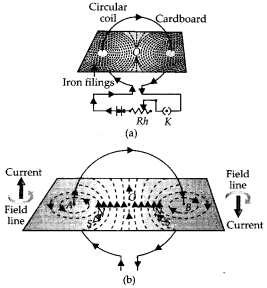
?- The magnetic field lines near the coil are nearly circular and concentric. This is due to the reason that the segments of the coil in contact with the board at the points A and B are almost like straight conductors. The direction of the field lines can also be found by applying right-hand thumb rule
?- The field lines are in the same direction in the space enclosed by the coil
?- Near the centre of the coil, the field lines are nearly straight and parallel. As such the magnetic field at the centre of the coil can be taken to be uniform
?- The direction of the magnetic field at the centre is perpendicular to the plane of the coil
?- As we move towards the centre of the coil, the strength of magnetic field increases. Magnetic field is maximum at its centre. This is due to the reason that the two magnetic field (one due to the semicircular segment of the coil through A and the other due to the semicircular segment through B) assist each other
- The magnitude of the magnetic field at the centre of the coil is directly proportional to the current flowing through it and total number of turns and inversely proportional to the radius of the coil. This is due to the reason that the current in all the circular turns of the coil is in the same direction. As such, the resultant magnetic field due to the coil is equal to the sum of the field due to all these turns
Question 17.
Draw the magnetic field lines through and around a single loop of wire carrying electric current?
Year of Question :(2016)
Answer:

Question 18.
What is a solenoid? Draw a diagram to show field lines of the magnetic field through and around a current carrying solenoid. State the use of magnetic field produced inside a solenoid. List two properties of magnetic lines of force?
Year of Question :(2015)
Answer:
Solenoid is used to form strong but temporary magnet called electromagnets. These electromagnets are used in wide variety of instruments and used to lift heavy iron, objects.
Properties of magnetic filed lines
Question 19.
State the effect of a magnetic field on the path of a moving charged particle?
Year of Question :(2014)
Answer:
A charged particle moving in a magnetic field may experience a force in the direction perpendicular to direction of magnetic field and direction of motion of particle. This force deflects the charged particle from its path
Question 20.
State the direction of magnetic field in the following case
 ?
?
Year of Question :(2012)
Answer:
Using Flemings left hand rule, the direction of magnetic field is out of the plane of paper
Question 21.
Write one application of Flemings left hand rule?
Year of Question :(2013)
Answer:
Flemings left hand rule is used to find the direction of force on a current carrying conductor placed in a magnetic field acting perpendicular to the direction of current
Question 22.
A current carrying conductor is placed in a magnetic field. Now answer the following?
Year of Question :(2012)
- (i) List the factors on which the magnitude of force experienced by conductor depends
- (ii) When is the magnitude of this force maximum
- (iii) State the rule which helps, in finding the direction of motion of conductor
- (iv) If initially this force was acting from right to left, how will the direction of force change if
- (a) direction of magnetic field is reversed
- (b) direction of current is reversed? (Board Term I, 2017)
Answer:
- (i) When a current carrying wire is placed in a magnetic field, it experiences a magnetic force that depends on
- (a) current flowing in the conductor
- (b) strength of magnetic field
- (c) length of the conductor
- (d) angle between the element of length and the magnetic field
- (ii) Force experienced by a current carrying conductor placed in a magnetic field is largest when the direction of current is perpendicular to the direction of magnetic field
- (iii) The rule used in finding the direction of motion of the conductor placed in a magnetic field is Flemings left hand rule.
Flemings left hand rule is as follows:
Stretch out the thumb, the forefinger, and the second (middle) finger of the left hand so that these are at right angles to each other. If the forefinger gives the direction of the magnetic field (N to S), the second (middle) finger the direction of current then the thumb gives the direction of the force acting on the conductor
- (iv) (a) Direction of force will be reversed when direction of magnetic field is reversed, i.e., now force on conductor will act from left to right
- (b) Direction of force will be reversed, if the direction of current is reversed, i.e., the force on the conductor will act from left to right
Question 23.
State whether an alpha particle will experience any force in a magnetic field if (alpha particles are positively charged particles)?
Year of Question :(2012)
- (i) it is placed in the field at rest
- (ii) it moves in the magnetic field parallel to field lines
- (iii) it moves in the magnetic field perpendicular to field lines.
Justify your answer in each case. (Board Term I, 2016)
Answer:
- (i) No, alpha particle will not experience any force if it is at rest, because only moving charge particle can experience force when placed in a magnetic field
- (ii) No, alpha particle will not experience any force if it moves in the magnetic field parallel to field lines because charge particle experiences force only when it moves at an angle other than 0° with magnetic field
- (iii) Alpha particle will experience a force in the direction perpendicular to the direction of magnetic field and direction of motion of alpha particle
Question 24.
Describe an activity with labelled diagram to show that a force acts on current carrying conductor placed in a magnetic field and its direction of current through conductor. Name the rule which determines the direction of this force?
Year of Question :(2012)
Answer:
A small aluminium rod suspended horizontally from a stand using two connecting wires. Place a strong horseshoe magnet in such a way that the rod lies between the two poles with the magnetic field directed upwards. For this, put the north pole of the magnet vertically below and south pole vertically above the aluminium rod.
 Connect the aluminium rod in series with a battery, a key and a rheostat. Pass a current through the aluminium rod from one end to other (B to A). The rod is displaced towards left. When the direction of current flowing through the rod is reversed, the displacement of rod will be towards right. Direction of force on a current carrying conductor is determined by Flemings left hand rule
Connect the aluminium rod in series with a battery, a key and a rheostat. Pass a current through the aluminium rod from one end to other (B to A). The rod is displaced towards left. When the direction of current flowing through the rod is reversed, the displacement of rod will be towards right. Direction of force on a current carrying conductor is determined by Flemings left hand rule
Question 25.
- (a) State Flemings left hand rule
- (b) Write the principle of working of an electric motor
- (c) Explain the function of the following parts of an electric motor
- (i) Armature (ii) Brushes (iii) Split ring (2018)
Answer:
- (b) Principle : Current carrying conductor when placed at right angle to a magnetic field, experiences a force due to which we get motion. The direction of the force is given by Flemings left hand rule
- (c) (i) Armature is a conductive part of motor which generates torque in the motor
- (ii) The two stationary brushes in a simple electric motor draw current from the battery and supply it to the armature of motor
- (iii) The role of split ring is to change the direction of current flowing through the coil after each half-rotation of coil
Question 26.
The change in magnetic field lines in a coil is the cause of induced electric current it. Name the underlying phenomenon?
Year of Question :(2020)
Answer:
The phenomenon in which electric current is generated by varying magnetic fields around a coil is called electromagnetic induction
Question 27.
Define the term induced electric current?
Year of Question :(2020)
Answer:
The current induced in a conductor when the magnetic field around it changes is known as induced electric current
Question 28.
Flemings Right-hand rule gives?
Year of Question :(2012)
- (a) magnitude of the induced current
- (b) magnitude of the magnetic field
- (c) direction of the induced current
- (d) both, direction and magnitude of the induced current. (2020)
Answer:
- (c) Flemings Right-hand rule gives the direction of induced current
Question 29.
What is the function of a galvanometer in a circuit?
Year of Question :(2019)
Answer:
Galvanometer is an instrument that can detect the presence of electric current in a circuit
Question 30.
Write any one method to induce current in a coil.?
Year of Question :(2019)
Answer:
By keeping the magnet in a fixed position and moving the coil towards and away from the magnet, we can induce current in the coil
Question 31.
Two coils of insulated copper wire are wound over a non-conducting cylinder as shown. Coil 1 has comparatively large number of turns. State your observations, when?
Year of Question :(2012)

- (i) Key K is closed
- (ii) Key K is opened
Give reason for each of your observations. (2020)
Answer:
- (i) When key is closed, after setting up the circuit as shown, one can observe a deflection on the galvanometer connected to the second coil. This is because, a potential difference and thus a current is induced in coil 2 as there is change in the current and the magnetic field associated with it in coil 1. When the magnetic field changes in coil 1, the magnetic field lines around coil 2 also changes. This induces a current in coil 2
- (ii) When key K is opened, after closing it for sometime it can be observed that the galvanometer show a deflection, but this time in the opposite direction. This is because, when the current stops flowing in coil 1, the magnetic field associated with it changes in the opposite direction as in the first case, thus inducing a current in the opposite direction
Question 32.
Two circular coils P and Q are kept close to each other, of which coil P carries a current. What will you observe in the galvanometer connected across the coil Q?
Year of Question :(2012)
- (a) if current in the coil P is changed
- (b) if both the coils are moved in the same direction with the same speed?
Give reason to justify your answer in each
Answer:
- (a) When the amount of current in the coil P is changed, an induced current will induce in the coil Q due to change in magnetic field lines i.e., magnetic flux
- (b) If both the coils are moved in the same direction with the same speed, then there is no net change in magnetic flux. Hence there will be no deflection in the galvanometer
Question 33.
In Faradays experiment if instead of moving the magnet towards the coil we move the coil towards the magnet. Will there be any induced current? Justify your answer. Compare the two cases. ?
Year of Question :(2017)
Answer:
Yes, these will be an induced current in both the cases as there is a change in the number of magnetic field line associated with the coil or we can say that there is a motion of a magnet with respect to the coil.
Same of current will be induced and the direction of flow of current will also be the same in the two cases
Question 34.
Write one application of Flemings right hand rule.?
Year of Question :(2013)
Answer:
Flemings right hand rule is used to find the direction of induced current
Question 35.
- (a) A coil of insulated copper wire is connected to a galvanometer. With the help of a labelled diagram state what would be seen if a bar magnet with its south pole towards one face of this coil is
- (i) moved quickly towards it
- (ii) moved quickly away from it
- (iii) placed near its one face
- (b) Name the phenomena involved in the above cases.
- (c) State Flemings right hand rule. (Board Term I, 2017)
Answer:
- (a) If a coil of insulated wire is connected to a galvanometer and a bar magnet with south pole is moved towards one face of the coil then, given situation is shown in the figure
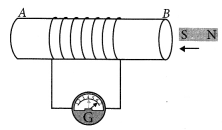
- (i) Moved quickly towards the coil : A current is induced in clockwise direction in the coil with respect to the side facing the north pole of the magnet and needle of galvanometer will deflect in one direction from zero position
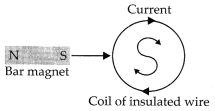
- (ii) Moved quickly away from coil : A current is induced in anti-clockwise direction in the coil with respect to the side facing the north pole of the magnet and the needle of the galvanometer will deflect in opposite direction from (i)
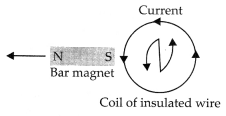
- (iii) Placed near its one face : No deflection of the needle of galvanometer is observed
- (b) The phenomena involved is called electromag-netic induction
- (c) Flemings right hand rule: Stretch the right hand such that the first finger, the central finger and the thumb are mutually perpendicular to each other.
If the first finger points along the direction of the field (magnetic field) and the thumb points along the direction of motion of the conductor, then the direction of induced current is given by the direction of the central finger
Question 36.
Write the frequency of alternating current (AC) in India. How many times per second it changes its direction?
Year of Question :(2015)
Answer:
The frequency of A.C. in India is 50 Hz and it changes direction twice in each cycle. Therefore, it changes direction 2 × 50 = 100 times in one second
Question 37.
How is the type of current that we receive in domestic circuit different from the one that runs a clock?
Year of Question :(2014)
Answer:
The current that we receive from domestic circuit is alternating current (A.C.) and the current that issuse to run clock is direct current (D.C.). Direct current always flow in one direction whereas the alternating current reverses its direction periodically
Question 38.
Define alternating current and direct current.
Explain why alternating current is preferred over direct current for transmission over long distances?
Year of Question :(2014)
Answer:
Alternating current (A.C.) : An electric current whose magnitude changes with time and direction reverses periodically is called alternating current.
Direct current (D.C.) : An electric current whose magnitude is either constant or variable but the direction of flow in a conductor remains the same is called direct current.
A.C. can be transmitted to distant places without much loss of electric power than D.C. That is why A.C. is preferred over D.C. for transmission of current over a long distances
Question 39.
- (i) Alternating current has a frequency of 50 Hz. What is meant by this statement? How many times does it change its direction in one second? Give reason for your answer
- (ii) Mention the frequency of D.C that is given by a cell. (Board Term I, 2013)
Answer:
- (i) The frequency of household supply of A.C. in India is 50 Hz. This means, A.C. completes 50 cycles in one second. Thus, A.C. changes direction 2 × 50 = 100 times in one second
- (ii) Frequency of D.C. is zero as its direction does not change with time
Question 40.
At the time of short circuit, the electric current in the circuit?
Year of Question :(2012)
- (a) vary continuously (b) does not change
- (c) reduces substantially
- (d) increases heavily. (2020)
Answer:
- (d) At the time of short circuit, the live and neutral wire come in direct contact, thus increasing the current in the circuit abruptly
Question 41.
Mention and explain the function of an earth wire. Why it is necessary to earth metallic appliances?
Year of Question :(2013)
Answer:
Many electric appliances of daily use like electric press, heater, toaster, refrigerator, table fan etc. have a metallic body. If the insulation of any of these appliances melts and makes contact with the metallic casing, the person touching it is likely to receive a severe electric shock. This is due to the reason that the metallic casing will be at the same potential as the applied one. Obviously, the electric current will flow through the body of the person who touches the appliance. To avoid such serious accidents, the metal casing of the electric appliance is earthed. Since the earth does not offer any resistance, the current flows to the earth through the earth wire instead of flowing through the body of the person
Question 42.
Give reason for the following :
The burnt out fuse should be replaced by another fuse of identical rating?
Year of Question :(2020)
Answer:
A burnt out fuse should be replaced with identical rating because it helps in protecting the circuit from overloading and short circuiting. If a fuse of higher rating is used then it may not melt and cut off the supply during overloading. Similarly a fuse of lower rating may melt frequently even for a normal flow of current. This results in decreasing the efficiency of the circuit
Question 43.
Give reasons for the following?
Year of Question :(2012)
- (a) It is dangerous to touch the live wire of the main supply rather than neutral wire
- (b) In household circuit, parallel combination of resistances is used
- (c) Using fuse in a household electric circuit is important. (Board Term I, 2017)
Answer:
- (a) Live wire is at 220V and neutral wire is at zero volt since the electric current flows from higher potential to lower potential, we can get an electric shock by touching live wire but that is not the case with neutral wire
- (b) In parallel combination, each resistor gets same potential from the source. We can use separate on/off switches with each appliance. Also in case if any one resistor fails then the circuit will not break. So, it is safe and convenient to connect household circuit in parallel combination of resistors
- (c) Fuse is an important safety device. It is used in series with any electrical appliance and protects it from short-circuiting and overloading
Question 44.
- (a) Fuse acts like a watchman in an electric circuit. Justify this statement
- (b) Mention the usual current rating of the fuse wire in the line to (i) lights and fans (ii) appliance of 2 kW or more power. (Board Term I, 2014)
Answer:
- (a) When an unduly high electric current flows through the circuit, the fuse wire melts due to joule heating effect and breaks the circuit. Hence, it keeps an eye on the amount of current flowing and also stops the current if exceeds the maximum value. So, fuse acts like a watchman in an electric circuit.
- (b) (i) A fuse of rating 5A is usually used for lights and fans
- (ii) A fuse of rating 15 A is usually used for appliance of 2 kW or more power
Question 45.
- (a) State Flemings Left-hand rule
- (b) List three characteristic features of the electric current used in our homes
- (c) What is a fuse? Why is it called a safety device
- (d) Why is it necessary to earth metallic electric appliances? (2020)
Answer:
- (b) (i) The electric current which we receive in our homes are alternating current with a frequency of 50 Hz
- (ii) There are mainly two wires used in the power supply provided to us. The one usually with a red insulation is called the live wire (or positive wire) and the one with black insulation is called the neutral wire (or negative wire). The potential difference between these wires is 220 V
- (iii) Often, there are two separate circuits used in our homes, one of 15 A current rating for appliances with higher power rating and the other circuit of 5 A rating for appliances such as fans, bulbs, etc
- (c) A fuse is safety device use to limit the current in an electric circuit
Question 46.
- (a) Name two safety measures commonly used in an electric circuit and appliances
- (b) What precaution should be taken to avoid the overloading of domestic electric circuits? (Board Term I, 2017)
Answer:
- (a) Fuse and the connection of earthing wire are the two safety measure commonly used in electric circuit and appliances
- (b) Provide fuses/MCBs of proper rating
Question 47.
- (a) Draw a schematic diagram of a common domestic circuit showing provision of
- (i) Earth wire, (ii) Main fuse
- (iii) Electricity meter and
- (iv) Distribution box
- (b) Distinguish between short circuiting and overloading. (Board Term I, 2015)
Answer:
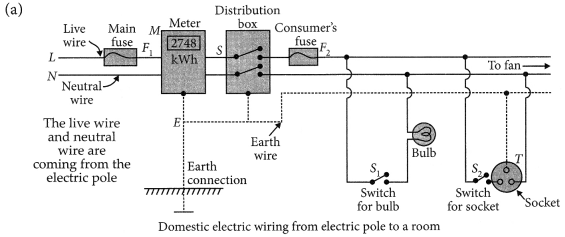
Important Questions and Answers: Chapter 13 - Magnetic Effects of Electric Current
Question 1.
What is a magnetic field? How can we represent it?
Answer:
Magnetic Field: The area around a magnet where its force can be felt.
Representation:
We represent magnetic fields using magnetic field lines.
Field lines start from the north pole and end at the south pole.
The closer the lines, the stronger the magnetic field.
Question 2.
What are the properties of magnetic field lines?
Answer:
Magnetic field lines:
Begin at the north pole and end at the south pole.
Never intersect with each other.
Closer field lines show a stronger magnetic field.
Inside the magnet, they go from south pole to north pole.
Question 3.
What is meant by electromagnetic induction? Who discovered it?
Answer:
Definition: The process by which a changing magnetic field induces an electric current in a conductor.
Discovered by: Michael Faraday in 1831.
Question 4.
Explain Fleming’s Left-Hand Rule.
Answer:
Fleming’s Left-Hand Rule:
Thumb: Shows the direction of force (motion).
Forefinger: Points in the direction of the magnetic field.
Middle finger: Indicates the direction of the current.
Question 5.
What is the right-hand thumb rule? Explain.
Answer:
Right-Hand Thumb Rule:
Imagine holding a straight current-carrying conductor with your right hand.
Thumb points in the direction of the current.
Fingers wrap around the conductor in the direction of the magnetic field lines.
Question 6.
How does a solenoid behave like a magnet?
Answer:
Solenoid: A coil of wire that generates a magnetic field when current passes through it.
It acts like a bar magnet, with one end as the north pole and the other as the south pole.
The magnetic field inside the solenoid is uniform and strong.
Question 7.
What is an electric motor? Explain its principle.
Answer:
Electric Motor: A device that converts electric energy into mechanical energy.
Principle: When a current-carrying conductor is placed in a magnetic field, it experiences a force.
This force causes the conductor to move, which in turn rotates the motor.
Question 8.
What is the difference between AC and DC current?
Answer:
AC (Alternating Current):
Direction of the current changes periodically.
Used in homes and industries.
Example: Power supply in homes.
DC (Direct Current):
Current flows in one direction.
Example: Batteries.
Question 9.
What is the function of a fuse in an electric circuit?
Answer:
Fuse:
Protects appliances from overloading or short-circuiting.
It is a safety device that melts when the current exceeds a safe level, thus breaking the circuit.
Question 10.
What is a generator and what principle does it work on?
Answer:
Generator: A device that converts mechanical energy into electrical energy.
Works on the principle of electromagnetic induction.
AC Generator: Produces alternating current (AC).
DC Generator: Produces direct current (DC).
Question 11.
What are the safety measures used in household electric circuits?
Answer:
Safety Measures:
Use of fuse to protect from overloading.
Earthing: Connecting the metallic body of appliances to the earth to prevent electric shocks.
Question 12. Explain the working of an electric motor with a diagram.
Answer:
Electric Motor Working:
It consists of a rectangular coil placed between the poles of a magnet.
When current flows, one side of the coil is pushed up and the other side is pushed down due to the magnetic field.
The split ring commutator ensures continuous rotation by reversing the direction of current.
Function: Converts electrical energy into mechanical energy.
Question 13.
How does overloading and short-circuiting occur?
Answer:
Overloading:
Happens when too many appliances are connected to the same circuit.
This causes the circuit to carry more current than it can handle.
Short-Circuiting:
Occurs when the live wire and neutral wire come into direct contact.
This causes a sudden increase in current, which can damage appliances.
Question 14.
What is a solenoid? How can it be used to create an electromagnet?
Answer:
Solenoid:
A coil of wire with many circular turns.
When current flows through it, it generates a magnetic field similar to a bar magnet.
Electromagnet:
A solenoid with a soft iron core becomes a strong magnet when electricity is passed through it.
Used in devices like electric bells and relays.
Question 15.
What is Fleming’s Right-Hand Rule?
Answer:
Fleming’s Right-Hand Rule:
Thumb: Represents the direction of the motion.
Forefinger: Points in the direction of the magnetic field.
Middle finger: Shows the direction of the induced current.